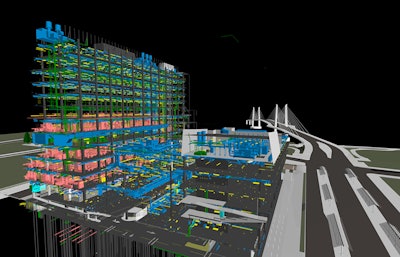
Building Information Modeling (BIM) has become an increasingly popular tool for not only project design but management of the life cycle of projects from conception to completion. It facilitates collaboration and data exchange between all project parties, reducing the potential for misunderstandings, errors or conflict.
The Definition of BIM (Building Information Modeling)?
BIM is “a process that begins with the creation of an intelligent 3D model and enables document management, coordination and simulation during the entire lifecycle of a project” from planning through to operation and maintenance. It is used to design and document building and infrastructure designs, with every detail modeled in the program. (Source: Autodesk, technology supplier)
“The model can be used for analysis to explore design options and to create visualizations that help stakeholders understand what the building will look like before it’s built,” Autodesk points out. “The model is then used to generate the design documentation for construction.”
What the Heck is BIM? And What Can It Actually Do?
So why is BIM important? As Autodesk describes: “BIM not only allows design and construction teams to work more efficiently but it allows them to capture the data they create during the process to benefit operations and maintenance activities. BIM data can also inform planning and resourcing on the project, city or country level. This is why BIM mandates are increasing across the globe.”
BIM has substantial benefits to offer. Yet, there are a number of misconceptions within the construction industry that can make potential users hesitate.
Myth #1: BIM is just a marketing hype for 3D modeling
“Although 3D modeling is an integral part of BIM, it is not its only component,” says Anastasios Koutsogiannis, content marketing manager at LetsBuild, in a guest blog on Excelize.com. “BIM is an over-encompassing 3D-based process that allows collaborative work between engineers, architects, contractors and building owners.”
BIM facilitates communication between designers and construction teams and can be used to coordinate data and information exchange. It gives all parties an open window to various aspects of the project throughout its life cycle.
Myth #2: BIM is for big firms and big projects
While BIM can be especially helpful on large, complex jobs, projects of all sizes essentially share the same problems.
“No matter the size, BIM is useful in calculating design costs and in saving time on estimating and budgeting,” Koutsogiannis points out. “BIM allows project members to make changes and update documents and plans automatically.”
Myth #3: BIM is expensive and time-consuming
BIM will require financial and time investments when first put into place, Koutsogiannis acknowledges. But studies show there is a 20% to 25% potential efficiency savings from working within a BIM environment.
Myth #4: BIM implementation requires a new staff team
According to Koutsogiannis, BIM implementation doesn’t have to be difficult, and existing staff can be trained in how to use it. “As a matter of fact, the most successful companies in implementing BIM are those who trained their existing project managers, engineers and teams to integrate BIM into their existing processes,” he writes.
Myth #5: BIM transition results in productivity losses that can’t be regained
This myth is based on old data, which suggests an average 25% to 50% productivity loss during initial transition and training. But any losses that do occur are quickly recovered by productivity and efficiency gains.
Final Thoughts
BIM can benefit all those involved in a construction project. “It allows a complete view of your entire project information while it communicates accurate data to all your relevant stakeholders,” Koutsogiannis states. Plus, it’s not as complicated to implement as you may think.
Don’t let these and other myths scare you away from exploring what could prove to be a highly useful tool for your business.
Digital Collaboration Slashes $10 Million in Costs from One Project
Value of BIM Significantly Increased in Water Projects Over Last 5 Years




















